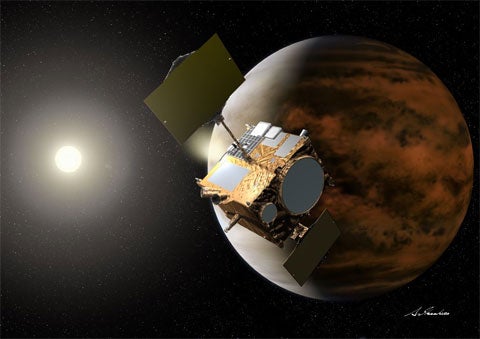Japan to Launch Venus-Bound Atmospheric Probe Today
The mission will study Venusian atmosphere; solar sail experiment hitches a ride

A probe to the solar system’s most hellish planet is set for launch later today in Japan. If all goes well, the Japanese Akatsuki probe, about the size of a small car, should reach the second planet by December, where it will study the sulfuric acid clouds of the Venusian atmosphere.
Launch time is set for 6:15 a.m. Tuesday in Japan — about 5:15 p.m. Eastern time Monday. Akatsuki means “dawn” in Japanese, a nod to Venus’ status as the morning star in that part of the world. The Japan Aerospace Exploration Agency, JAXA, which developed the probe, is calling it the first meteorological satellite on another world.
Attempts to study Venus from the ground up have failed after a couple hours because the place is so utterly inhospitable. Intense heat and pressure cook any probes lucky enough to land on the surface — the record for surface survival is 127 minutes, held by the Russian probe Venera 13, which landed March 1, 1982. Many other probes never even made it to the ground, succumbing to intense atmospheric pressures during descent.
But surviving in the upper atmosphere is a little easier. Akatsuki will fly in an equatorial orbit between the atmosphere’s top layers to an altitude of about 50,000 feet, where it will study Venus’ violent winds and acid clouds. Instruments on board will look for volcanic activity, which scientists recently said may be much more recent than previously thought.
It also has a high-speed camera that aims to capture lightning, which is presumed to occur on Venus but has never been observed directly.
The probe will work in concert with the European Space Agency’s Venus Express satellite, which has been in a polar orbit around Venus since 2006.
Scientists like to study Venus because it is so much like Earth; the planets formed in similar ways. It’s also an example of a runaway greenhouse effect — the atmosphere is almost entirely made of carbon dioxide, keeping the planet super-hot — and scientists think it can illuminate aspects of Earth’s own atmospheric evolution.
Akatsuki is riding to space along with another probe, a solar sail called Ikaros that aims to prove the sun can be used for interplanetary propulsion.

Space Sailing